Disclaimer
This information HAS errors and is made available
WITHOUT ANY WARRANTY OF ANY KIND and without even the
implied warranty of MERCHANTABILITY or FITNESS FOR A
PARTICULAR PURPOSE. It is not permissible to be read by
anyone who has ever met a lawyer or attorney. Use is confined to
Engineers with more than 370 course hours of engineering.
If you see an error contact:
+1(785) 841 3089
inform@xtronics.com
Health effects of
different fatty acids
Related pages
- Health effects of different fatty
acids
- Related pages
- Fatty acids
- Simplified Table of Fat groups
and their effects
- Other Fats
- LA
-
- LA Thyroid connection?
- Dietary Sources
- Conventional oils
-
- Olive oil
- Fat contents of food
- Consumption of ω-6 and seed oil
over time
-
- Refs
- o-3 vs o-6 Ratios
- Warning About Junk Science
- Related pages
Fatty acids
Humans mostly make Sat-Fats from high carb diets. Mammalian fatty
acyl desaturases can introduce double bonds at the Δ5, Δ6 and Δ9
positions This means that we cannot introduce double bonds at the
ω3 or ω6 positions.
Simplified Table
of Fat groups and their effects
It appears that PUFA's and perhaps MUFA's can induce
inappropriate insulin sensitivity - the end result would be
weight gain.
Insulin Sensitivity = opposite of insulin Resistance ( Best to
think in positive/Sensitivity terms - positive means Fat going
into tissue. )
| Type |
Insulin
Level |
Muscle
Insulin
Sensitivity |
Adipose
Insulin
Sensitivity |
2 week effect? |
| SAFA |
up |
up |
Down |
|
| MUFA |
? |
? |
down
depends * |
|
| ω-6 FA |
? |
? |
Strong UP |
|
| ω-3 short-chain |
? |
? |
UP |
|
| ω-3 Long-chain |
? |
? |
UP |
|
| Transfats |
? |
? |
up |
|
| Sugars |
UP |
? |
? |
|
- * MUFA modify SFA insulin resistance when both SFA and glucose
are present and abort the apoptotic signal(s) generated when
hyperglycaemia and SFA are present concurrently and insulin
resistance is not wanted (ie post prandially). MUFA generation
is controlled by insulin through SCD1.
- Adipocytes with enough fat become insulin resistant - SFA to
MUFA ratio will go to pot as adequate MUFA will not be generated
in hyperglycaemia because the adipocytes are not listening to
insulin. The problem can be delayed for years by increasing PUFA
(and maybe MUFA) dietary intake to re establish insulin
sensitivity, especially in distended adipocytes, so metabolism
appears to improve while ever the ability to get fatter also
restored, until this is finally used up.
- When fat gain increases, fat is stored, insulin sensitivity is
excellent UNTIL adipocytes develop distension induced insulin
resistance. Then hyperinsulinaemia and hyperglycaemia follow on
when glucose is fed...
- Insulin inhibits lipolysis (break down of lipids ) and
suppresses glucose release from the liver. The liver extracts
between 50% and 80% of all of the insulin produced by the
pancreas. Relatively little ever gets to the systemic
circulation (The liver receives about 75% of its blood through
the hepatic portal vein, a blood vessel that conducts blood from
the gastrointestinal tract and spleen to the liver.) The residue
of insulin is what should be controlls adipocyte function.
- SFA generate superoxide and switch off glucose metabolism (ie
cause insulin resistance) so maintain fasting glucose for brain
use.
- Fasting induces adipocyte insulin resistance as well as
hypoinsulinaemia and hence fat mobilisation... All physiological
as apposed to autonomic nervous system control.
- We need insulin resistance to lose weight and can be a good
thing if glucose is not elevated.
- Each cycle of beta oxidation (assuming an even numbered
carbon chain fully saturated fatty acid) produces one FADH2,
one NADH and one acetyl-CoA. This gives a total of 2FADH2
inputs and 4 NADHs per cycle of beta oxidation. But the very
last pair of carbon atoms in a saturated fat do not need to go
through beta oxidation as they already comprise acetate
attached to CoA, so they can simply enter the TCA as
acetyl-CoA. This last step only produces 1 FADH2 and 3 NADHs,
with no extras.
- So the shorter the fatty acid, the less FADH2 per unit NADH
it produces. Short chain fatty acids like C4 butyric acid have
an F:N ratio of 0.43 while very long chain fatty acids, up at
26 carbons, have an F:N ratio of about 0.49.
- As Dr Speijer points out, differing length fatty acids are
dealt with differently. Very short chain fatty acids head
straight for the liver and get metabolised by hepatic
mitochondria immediately. Any excess acetyl-CoA gets
off-loaded as ketones.
- Very long chain fatty acids end up in peroxisomes for
shortening, usually to C8, which is then shunted to
mitochondria for routine beta oxidation. Of course peroxisomal
beta oxidation generates zero FADH2, except that from
acetyl-CoA, because peroxisomal FADH2 is reacted directly with
oxygen to give H2O2. And heat, of course.
- Bear in mind that the ratio of F:N generated by a metabolic
fuel sets the ability to generate reverse electron flow
through complex I and subsequent superoxide production,
macroscopically described as insulin resistance.
- So fatty acids up to C8 are cool, dump them to the liver
and make a few ketones. Very long chain fatty acids over C18,
shorten to C8 in peroxisomes, shift them to mitochondria and
make some ketones if needs must. The F:N ratio of C8 is about
0.47, a value chosen by metabolism as the end product of
peroxisomal shortening. The number is important. Actually the
number is even lower as peroxisomal beta oxidation generates
the NADHs of beta oxidation, just not the FADH2s, but why
allow facts like this to spoil a great argument. C8 from
breast milk and/or coconuts seems fine and has that F:N ratio
of 0.47.
- Now the area of interest is, of course, C16, palmitic acid.
This has an F:N ratio of about 0.48, almost as superoxide
generating as a C26 fatty acid up at 0.49. And palmitic acid
does, without any shadow of a doubt, produce macroscopic
insulin resistance. That's 15 FADH2s and 31 NADHs.
- So an F:N of 0.47 is not a serious generator of superoxide
and an F:N of 0.48 is.
- What happens when we drop a double bond in to palmitic
acid? Mitochondrial beta oxidation generates FADH2 as it drops
a double bond in to the saturated fat chain. If the double
bond is already there, hey, no FADH2!
- Palmitoleate has one double bond. This of course gives 14
FADH2s and 31 NADHs, an F:N ratio of 0.45.
- Palmitate 0.48
- C8 caprylic 0.47, chosen by peroxisomes to hand to
mitochondria
- Palmitoleic 0.45
- Adding a single double bond to palmitic acid drops its F:N
ratio from significantly superoxide generating to minimally
superoxide generating. It looks like a switch to me.
List of Saturated
Fatty Acids
- Saturated fat raises LDL.
- 2.0 Acetic Acid
- 3:0 Propionic acid -21°C (Propanoic acid)
- 4:0 Butyric acid (Butanoic acid)-7.9°C(short chain) F:N ratio
0.43
- 5:0 Valeric acid (Pentanoic acid) −34.5°C
- 6:0 Caproic acid (Hexanoic acid)−3.4°C (short chain)
- 7:0 Heptanoic(Enanthic, Oenanthic) acid (Heptanoic acid) −7.5
°C
- 8:0 Caprylic acid (Octanoic acid)16.7°C (medium chain)F:N
ratio about 0.47 chosen by peroxisomes to hand to mitochondria
- 9:0 Pelargonic acid (Nonanoic acid)
- 10:0 Decanoic(Capric ) acid 31.6°C (medium chain)
- 11:0 Undecylic acid (Undecanoic acid)
- 12:0 Lauric(dodecanoic)acid 43.8°C (medium chain) - main acid
in coconut oil
- 13:0 Tridecylic acid (Tridecanoic acid)
- 14:0 Myristic acid, (tetradecanoic acid) 54.4°C - found in
palm oil, coconut oil, butter fat,
- 15:0 Pentadecylic acid (Pentadecanoic acid)
- 16:0 palmitic acid (Hexadecanoic acid) 62.9°C F:N ratio of
about 0.48 That's 15 FADH2s and 31 NADHs - oxidizing . (palm oil
- Butter, cheese, milk and meat also have some)
- 17:0 Margaric acid (Heptadecanoic acid) - in Milk
- 18:0 Stearic acid (Octadecanoic acid) 69.3°C Found in Cocoa
- Stearic acid is the only long chain saturated fatty acid
that does not raise LDL cholesterol(reference?).
- Also - stearic acid has been shown associated with
increases in Lp(a)
- 19:0 Nonadecylic acid (Nonadecanoic acid) 69°C
- 20:0 Arachidic acid (Eicosanoic acid)75.5°C
- 21:0 Heneicosylic acid (Heneicosanoic acid)
- 22:0 Behenic acid (Docosanoic acid) found in Ben oil, rapeseed
(canola) and peanut oil
- 23:0 Tricosylic acid (Tricosanoic acid)
- 24:0 Lignoceric acid (Tetracosanoic acid)
- 25:0 Pentacosylic acid (Pentacosanoic acid)
- 26:0 Cerotic acid (Hexacosanoic acid) F:N ratio of about 0.49
- 27:0 Heptacosylic acid (Heptacosanoic acid)
- 28:0 Montanic acid (Octacosanoic acid)
- 29:0 Nonacosylic acid (Nonacosanoic acid)
- 30:0 Melissic acid Triacontanoic acid)
- 31:0 Henatriacontylic acid (Henatriacontanoic acid)
- 32:0 Lacceroic acid (Dotriacontanoic acid)
- 33:0 Psyllic acid (Tritriacontanoic acid)
- 34:0 Geddic acid (Tetratriacontanoic acid)
- 35:0 Ceroplastic acid (Pentatriacontanoic acid)
- 36:0 Hexatriacontylic acid (Hexatriacontanoic acid)
Other Fats
- 16:1
- 16:1ω-7 Palmitoleic Acid AKA POA F:N ratio of 0.45 -
biosynthesized from palmitic acid via SCD1 - Increases insulin
sensitivity by suppressing inflammation via FAS, as well as
inhibit the destruction of insulin-secreting pancreatic beta
cells. Short term this looks like a good effect - but long term
causes weight gain.
- 18:1
- 18:1 trans-9 Elaidic acid very bad. This is the major trans
fat found in hydrogenated vegetable oils and occurs in small
amounts in caprine and bovine milk (very roughly 0.1% of the
fatty acids) [1] and some meats. Elaidic acid (C18:1) (2-5% of
the fatty acid in beef), which can raise LDL in serum (Abbey and
Nestel, 1994; Muller et al., 1999, Judd et al., 2002). These
different numbers may reflect different feeds that beef get.
LA
LA
speculation
- 18:2 ω-6 linoleic acid -5°C increases LDL oxidation -
One really does not want to eat much of this - varnish,
linoleum, industrial waste.
LA Thyroid
connection?
-
Dietary Sources
| Name |
% LA† |
| Safflower Oil |
78% |
| Grape Seed Oil |
73% |
| Poppy Seed Oil |
70% |
| Sunflower Oil |
68% |
| Hemp Oil |
60% |
| Corn Oil |
59% |
| Wheat Germ Oil |
55% |
| Cottonseed Oil |
54% |
| Soybean Oil |
51% |
| Walnut Oil |
51% |
| Peanut Oil |
48% |
| Sesame Oil |
45% |
| Rice Bran Oil |
39% |
| Pistachio Oil |
32.7% |
| Canola Oil |
21% |
| Egg Yolk |
16% |
| Linseed oil |
15% |
| Lard |
10% |
| Olive Oil |
10% |
| Palm Oil |
10% |
| Cocoa Butter |
3% |
| Macadamia Oil |
2% |
| Butter |
2% |
| Coconut Oil |
2% |
| |
†average val |
- 18:3 ω-3 alpha linolenic acid or ALA
- 18:3 ω-6 gamma-linolenic acid or GLA
- 18:3 ω-6 Calendic acid - a trans form of Linoleic
- 18:4 ω-3 Stearidonic acid (STD)
- 20:1
- 20:2 ω-6 Eicosadienoic acid
- 20:3 ω-3 Eicosatrienoic acid (ETE) anti-inflammatory - goes up
on low LA diet Dietary
(n-9) eicosatrienoic acid from a cultured fungus inhibits
leukotriene B4 synthesis in rats and the effect is modified by
dietary linoleic acid.
- 20:3 ω-6 Dihomo-gamma-linolenic acid (DGLA)inflammatory
neutral -from dietary GLA (18:3 ω-6) found in, e.g. borage oil
- 20:4 ω-6 arachidonic acid or AA Inflammatory Most AA in the
human body derives from dietary linoleic acid (another essential
fatty acid, 18:2 ω-6)
- 20:4 ω-3 eicosatetraenoic acid (ETA)
- 20:5 ω-3 eicosapentaenoic acid (EPA) Anti-inflammatory - from
oily fish or derived from dietary alpha-linolenic acid found in,
for instance, hemp oil and flax oil
- 22:1 ω-9 Erucic acid - adversely affect heart tissue in Rats
- 22:2 ω-6 Docosadienoic acid
- 22:4 ω-6 Adrenic acid.
- 22:5 ω-3 Docosapentaenoic acid (DPA, Clupanodonic acid)
- 22:5 ω-6 Docosapentaenoic acid (Osbond acid)
- 22:6 ω-3 docosahexaenoic acid or DHA
- 24:1 ω-9 Nervonic acid
- 24:5 ω-3 Tetracosapentaenoic acid
- 24:6 ω-3 Tetracosahexaenoic acid (Nisinic acid)
- stearic and myristic acid-rich saturated fats increase large
LDL cholesterol; palmitic acid somewhat. (reference?)
Conventional oils
Olive oil
Heart healthy - seems to reduce oxLDL - does contain some
palmitic and linoleic acid
Fat contents of
food
These values may vary - year to year - LA in particular has
increased with livestock eating ever more corn. Some measures vary
+/- 2:1
| Saturated, Monounsaturated, and
Polyunsaturated Fats in Various Fats and Oils in percent |
|
short chain |
medium chain |
long chain |
|
|
|
|
|
| carbons |
4:00 |
6:00 |
8:00 |
10:00 |
12:00 |
14:00 |
16:00 |
18:00 |
|
|
|
|
|
| name |
butyric |
caproic |
caprylic |
capric |
lauric |
myristic |
palmitic |
stearic |
sat |
mono |
poly |
n-6 |
n-3 |
| PLANT OILS |
| canola oil |
|
|
|
|
|
|
4 |
2 |
6 |
62 |
32 |
23 |
11 |
| cocoa butter |
|
|
|
|
|
|
28 |
32 |
60 |
38 |
2 |
2 |
0 |
| coconut oil |
|
1 |
8 |
6 |
50 |
17 |
8 |
3 |
92 |
6 |
2 |
2 |
0 |
| corn oil |
|
|
|
|
|
|
12 |
2 |
14 |
28 |
58 |
57 |
1 |
| cottonseed oil |
|
|
|
|
|
|
14 |
15 |
29 |
19 |
52 |
52 |
0 |
| flax seed |
|
|
|
|
|
|
6 |
3 |
9 |
18 |
73 |
16 |
57 |
| olive oil |
|
|
|
|
|
|
10 |
3 |
13 |
75 |
12 |
11 |
1 |
| palm kernel oil |
|
0 |
3 |
4 |
51 |
17 |
9 |
3 |
87 |
11 |
2 |
2 |
0 |
| palm oil |
|
|
|
|
|
1 |
45 |
5 |
51 |
40 |
9 |
9 |
0 |
| peanut oil |
|
|
|
|
|
|
10 |
2 |
21 |
47 |
32 |
32 |
0 |
| safflower oil |
|
|
|
|
|
|
4 |
2 |
7 |
15 |
78 |
75 |
0 |
| sesame oil |
|
|
|
|
|
|
10 |
5 |
15 |
41 |
44 |
44 |
0 |
| soy oil |
|
|
|
|
|
|
14 |
6 |
20 |
27 |
53 |
50 |
0 |
| sunflower oil |
|
|
|
|
|
|
8 |
4 |
12 |
19 |
69 |
68 |
1 |
| ANIMAL FATS |
| beef fat |
|
|
|
|
|
7 |
30 |
15 |
52 |
45 |
3 |
3 |
0 |
| beef fat, grass-fed |
|
|
|
|
|
3 |
26 |
19 |
49 |
46 |
5 |
5 |
0 |
| bison fat, grass-fed |
|
|
|
|
|
2 |
22 |
25 |
49 |
46 |
6 |
6 |
0 |
| chicken fat |
|
|
|
|
|
1 |
24 |
6 |
31 |
48 |
21 |
20 |
0 |
| duck & goose fat |
|
|
|
|
|
1 |
28 |
6 |
35 |
52 |
13 |
13 |
0 |
| human fat |
|
|
|
|
|
3 |
20 |
4 |
27 |
53 |
19 |
16 |
2 |
| lard |
|
|
|
|
|
1 |
26 |
13 |
40 |
48 |
12 |
12 |
0 |
| venison fat |
|
|
|
|
|
4 |
27 |
33 |
64 |
27 |
8 |
8 |
0 |
| egg yolk |
|
|
|
|
|
|
27 |
10 |
37 |
46 |
17 |
16 |
0 |
| DAIRY |
| butter |
4 |
3 |
2 |
3 |
3 |
10 |
30 |
13 |
68 |
28 |
4 |
4 |
0 |
| cheese, cheddar |
3 |
2 |
1 |
2 |
2 |
11 |
32 |
13 |
66 |
31 |
3 |
3 |
0 |
| cheese, swiss |
4 |
2 |
1 |
2 |
2 |
12 |
31 |
13 |
67 |
29 |
4 |
4 |
0 |
| cream, heavy |
3 |
2 |
1 |
3 |
3 |
11 |
28 |
13 |
65 |
31 |
4 |
4 |
0 |
| SEAFOOD |
| anchovy |
|
|
|
|
|
7 |
17 |
6 |
31 |
29 |
40 |
4 |
36 |
| herring, atlantic |
|
|
|
|
|
7 |
17 |
1 |
26 |
47 |
27 |
6 |
21 |
| salmon, farmed |
|
|
|
|
|
5 |
18 |
5 |
28 |
36 |
37 |
13 |
24 |
| salmon, wild |
|
|
|
|
|
2 |
11 |
4 |
17 |
37 |
45 |
15 |
31 |
| sardine oil |
|
|
|
|
|
7 |
18 |
4 |
29 |
36 |
34 |
10 |
25 |
| seal oil, alaskan |
|
|
|
|
|
6 |
10 |
1 |
17 |
63 |
21 |
5 |
16 |
| trout, farmed |
|
|
|
|
|
4 |
20 |
6 |
30 |
32 |
38 |
18 |
19 |
| trout, wild |
|
|
|
|
|
3 |
14 |
5 |
22 |
37 |
41 |
18 |
23 |
| whale oil, beluga |
|
|
|
|
1 |
7 |
8 |
1 |
18 |
68 |
14 |
3 |
11 |
- Corn oil C16:0 10.9%; C18:0 2.0%; C20:0 0.4%; C16:1 0.2%;
C18:1 25.4%; C18:2 59.6%; C18:3 1.2% Source: Richard O'Brien
"Fats and Oils: Formulating and Processing for Applications"
- Grass-fed
beef
Consumption of ω-6
and seed oil over time
While correlation does not show causation - it seems it would be
prudent to figure out if LA is what is driving the obesity
pandemic. There is a problem in such studies as according to one
paper there is a 600day half-life to contend with. This half-life
could be separating cause and effect so that people don't pick up
on what is doing them harm. It would be fairly easy to find a
correlation with LA in adipose tissue with obesity.
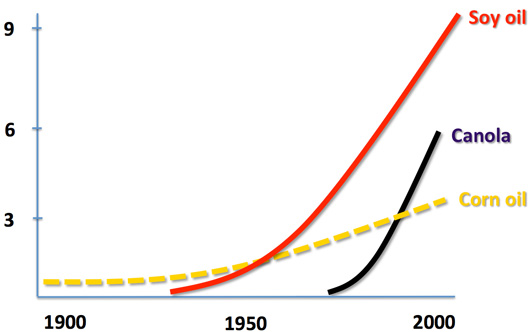
Omega-6-consumption-from-seed-oils

"The linoleic acid content of body fat has increased tremendously
in the US over the last 50 years, as shown in the following graph,
based on a number of different studies, each of which is
represented by an orange dot
Refs
 LA in Human Fat
LA in Human Fat
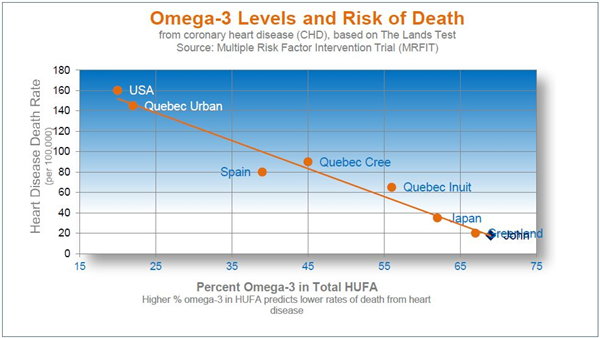
Omega-3 vs heart risk
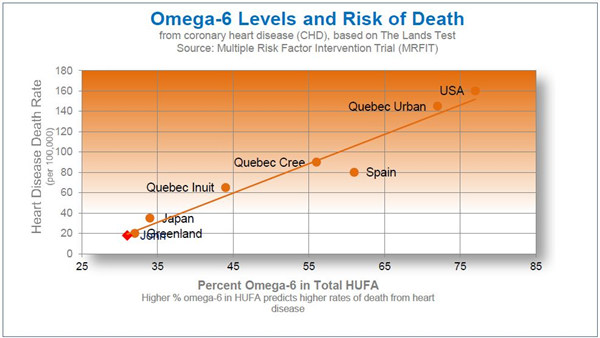
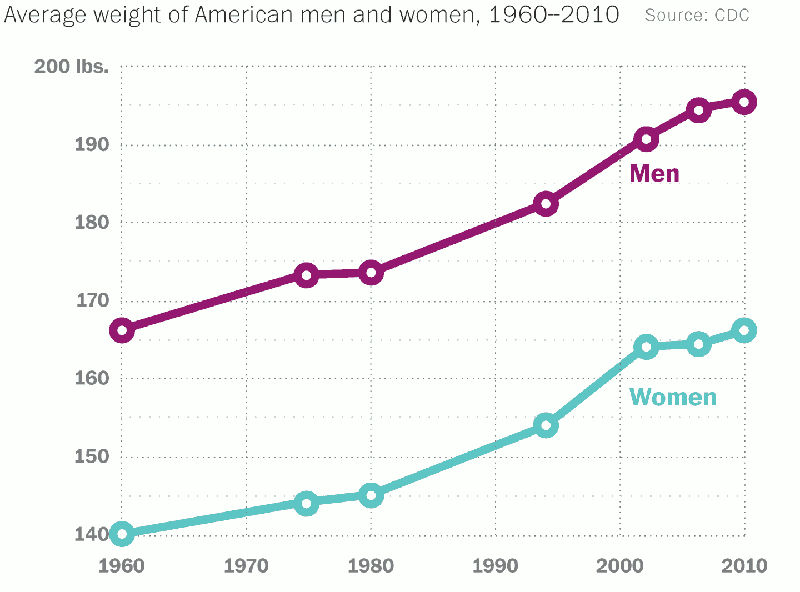
US-weight-1960-2010
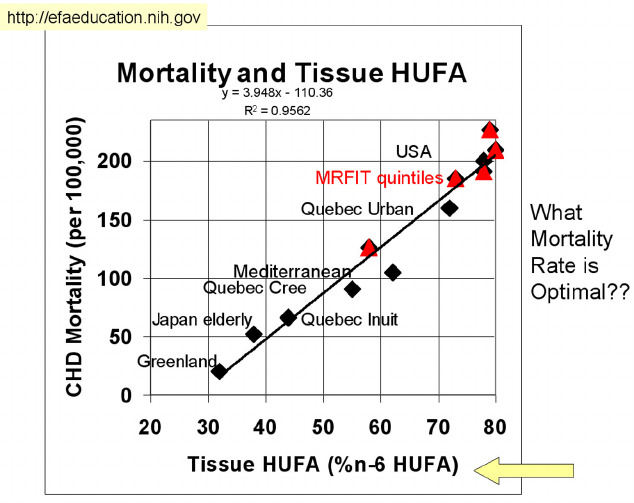
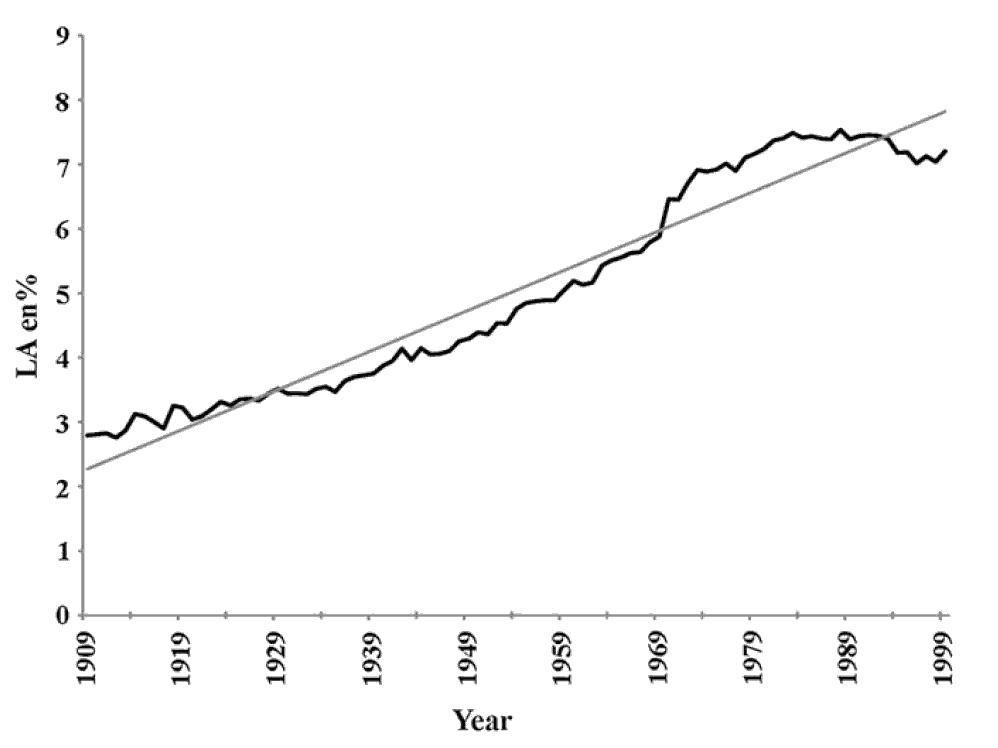
o-3 vs o-6 Ratios
There are many people promoting fish oil to balance this ratio -
no one questions if that is the right way. All PUFA's mess with
insulin sensitivity - so fish-oil has the potential to cause
obesity. Also - the amount of PUFA in the diet effects the
permeability of cell membranes - effecting even our immune system.
So 8-OHdG (8-oxo-guanosine) is a marker of oxidative stress
- part of DNA repair. Marker of increased cancer causing
problems. It appears that LA likely increases this marker.
Lipid peroxides as
endogenous oxidants forming 8-oxo-guanosine and lipid-soluble
antioxidants as suppressing agents
Warning About Junk
Science
Related pages
Email lrak@lrak.net

